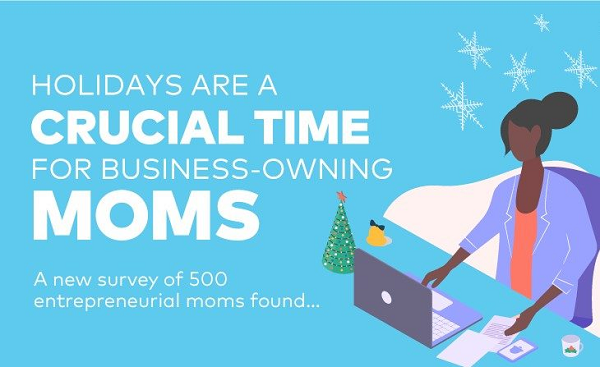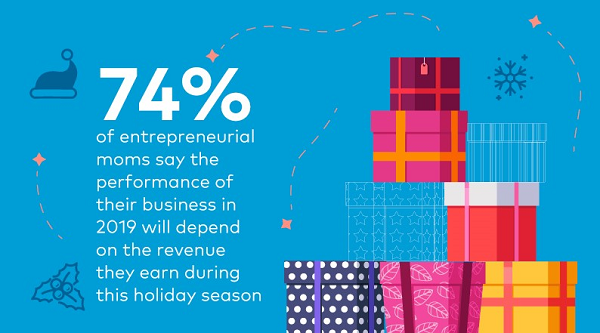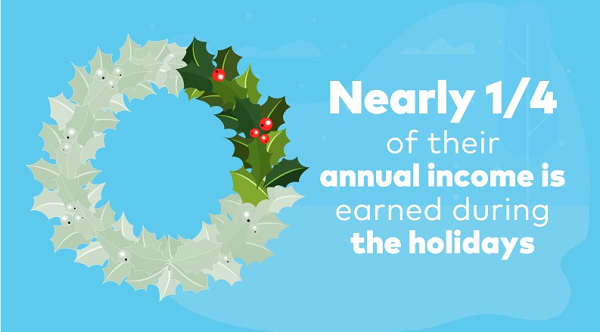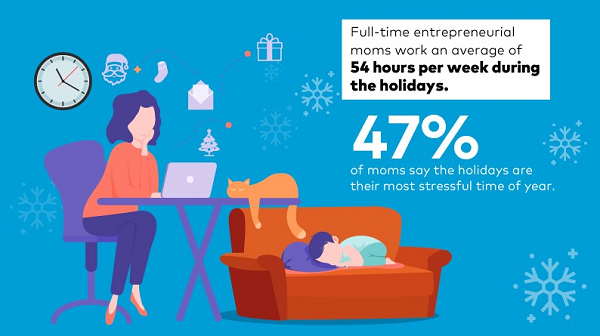14 Things Small Business Owners Need to Know
By Rieva Lesonsky
1—Holidays are a Crucial Time for Business-Owning Moms 
Vistaprint surveyed entrepreneurial moms to find out how the holidays impact their businesses, their stress levels, and their work/life balance. The answers are in the infographic below.
2—The Plight of Independent E-Tailers
While last year’s holiday season was a profitable one for online retailers, even more records are likely to be broken this year as online shoppers hit the web for holiday gifts, deeply discounted items, and one-day sales. From Black Friday through the new year, the weeks surrounding the holidays are some of the busiest—and most rewarding—for online retailers. But like most things that come with hard work, the challenges solo online retailers face can be both personal and business-related.
A new survey from QuickBooks Self-Employed reveals some of the challenges and opportunities for online retailers. This time of year is a crucial one for these folks—33% of them make 50% or more of their profits during the holiday season.
But what impact does the holiday rush have on the personal lives of these online retailers who are going it alone during the holidays? No surprise, quality personal time takes a backseat. The personal impact of working your retail off during the holidays is different for everyone.
The top 5 personal struggles for solo retailers during the holidays
- Finding time for themselves
- Finding time for family
- Not being able to relax or enjoy the holidays
- Stress
- Not having enough time or money to buy gifts
These personal challenges aren’t surprising, since the study also found more than 80% of retailers work extra hours each week during the holidays.
There’s a lot more helpful information in the article. Check it out here.
3—Americans Prefer to Buy from Socially-Conscious Companies
Americans are shopping with a purpose these days—54% consider themselves to be socially-conscious shoppers, and 63% prefer to purchase holiday gifts from brands that support specific social causes. These are the findings of a new survey from SAP SE which asked consumers about their purchasing habits to understand the correlation between their purchases and “brand purpose.”
The study also shows 60% of consumers avoid buying from brands that support causes they disagree with during holiday shopping.
“We live in an experience economy in which consumers care not just about products but also about a company’s purpose, value and global impact”, says Alex Atzberger, president of SAP’s customer experience organization. “Our survey findings indicate that when a company closely connects its purpose to the brand, chances are customers will relate to it on a more personal, human level — which supports customer loyalty and completes the customer experience.”
Additional insights from the survey:
Consumers are willing to pay more for values: More than half of respondents say they would spend more for a holiday purchase from a brand that strongly supports a cause or represents specific values.
Brand values are second only to price when making purchasing decisions: Brand values matter more than a previous positive or negative experience with a brand, how user friendly a website is and if the brand has a physical store nearby.
Brands must be transparent in business practices: 67% of consumers say transparency in business practices is essential for brands to prove authenticity.
Shoppers want their values to align with brands: The values most important to shoppers this holiday season are environmental sustainability, education and diversity and inclusion.
4—Attracting New Shoppers to Your Store
In 2017 almost half of consumers shopped at stores that were new to them. And Google research shows 61% of shoppers are likely to do that this year. Additionally, close to 80% of shoppers will go to the store to buy when there’s an item in stock they need or want immediately.
To help small businesses reach new customers and attract foot traffic during the crowded holiday season, Google has compiled a list of top tips for optimizing your online and mobile presence.
Build an online presence: Google My Business platform is a great place to start. It’s free and an easy way for businesses to show up in Google Search and Maps. This is key to finding new customers because consumers usually start their journey searching online. In fact, mobile searches for “where to buy” grew over 85% in the past two years, with queries like “where to buy ugly Christmas sweater,” “where to buy cards” and “where to buy gift boxes.”
Update your holiday hours: Mobile searches for “open now” and “store hours” grow through December and peak on Christmas Day. Update your holiday hours through Google My Business so you don’t miss out on potential customers.
Make sure your website is mobile-optimized: 53% of visits are abandoned if a mobile website takes longer than 3 seconds to load. Using Google’s Test My Site tool, you can test your site’s mobile speed and receive custom tips to improve your website.
Promote your business and reach your customers across devices: Google Ads makes advertising radically simpler. Businesses choose their business goals and machine learning goes to work to deliver results. Customers can create ads in minutes and drive results they care about most like phone calls, actions on their website, and store visits.
5—Are Customers Turned Off by Your Holiday Music?
A new study from Cloud Cover Music asked consumers how holiday music impacts their retail experience—for better or worse.
Study highlights:
- Religious holiday makes 21% of shoppers angry—in fact, it discourages 39% of millennials and 31% of Gen Xers from shopping
- 39% of retail workers say stores should start playing holiday music in late November, but 35% say it should wait until early December. Oddly, 5% say August is the month to start (Editor’s note: It’s not)
- Traditional holiday music makes shoppers happy (56%), encourages spending (58%) and increases time spent in stores (48%)
6—10 Ways to Thank Your Employees this Holiday Season
Finding and keeping qualified employees is a challenge for most small business owners. One of the keys to retaining your staff is to make sure your employees feel appreciated by you. In fact, studies show 79% of employees actually quit their jobs because they simply do not feel appreciated.
Read this from Sterling Talent Solutions and learn 10 great ways to thank your team.
7—Guide to Holiday Tipping
Northeasterners give holiday gifts and tips more often than Americans in other parts of the country. According to a new Consumer Reports survey 69% of Americans from the Northeast reported giving a tip last holiday season, compared to 60%—or less—of Americans from the Midwest, South and West. When it comes to generations, Gen Xers were more generous – averaging a gift around $50, compared with $40 for millennials. So how do you know who to tip, and how much. Check out these tips on tipping.
8—Best Smartwatches for Teens
Have a teen and stumped what to get them this year? Check out this guide to the best smartwatches for teens from Knoji.
9—Small Business Owners are Confident
Twice a year Bank of America issues its Small Business Owner Report exploring the concerns, aspirations and perspectives of small business owners across the country.
Key insights from the fall 2018 Bank of America Small Business Owner Report include:
80% of entrepreneurs are confident their 2018 year-end revenue will exceed that of 2017. In addition, over the next 12 months:
- 57% of business owners believe their revenue will increase
- 67% plan to expand
- 27% plan to hire (
- 55% are confident the national economy will improve
- 54% are similarly confident in their local economies
- 15% intend to apply for a loan
All those numbers are higher than they were in last fall’s survey.
As small business hiring ramps up, competition for talent heightens, which is challenging for many small business owners as they plan to hire next year. Among the business owners who tried to hire new employees, 50% say the tightening labor market had a direct impact on their ability to find and hire qualified candidates. In response, they’ve modified their hiring strategies to find and recruit top talent by:
- Shifting to a more flexible culture in terms of hours, location and extra time off (25%)
- Using social media more actively (23%)
- Offering higher salaries (17%)
- Promoting how the business impacts the local community and highlighting charitable work (12%)
- Using an outside recruiter (9%)
Their top economic issues are:
- Health care costs (63% vs. 72% in fall 2017)
- Interest rates (44% vs. 43% in fall 2017)
- Trade policies (43%; issue not surveyed in 2017)
Despite the unique challenges involved in managing a small business, entrepreneurs love what they do—91% say the added stress of entrepreneurship has been worth it, and 90% would recommend that others follow in their footsteps. Business owners are feeling the holiday spirit, as 83% plan to offer at least one holiday perk to their employees.
The top holiday perks being offered are:
- Office closures (50%)
- Flexible hours or vacation time (41%)
- Salary bonuses (38%)
10—An Update on the New, 20% Deduction for Small Business Owners
Guest post by Mike D’Avolio Intuit’s Senior Tax Analyst
The Tax Cuts and Jobs Act, signed into law on Dec. 22, 2017, provided sweeping tax changes, especially for small business owners. In preparation for Tax Year 2018, one of the most notable updates for tax professionals and small businesses to be aware of is the new 20% deduction for small businesses and self-employed workers.
Beginning in Tax Year 2018, pass-through income from sole proprietors (Schedule C on Form 1040), limited liability companies, partnerships and S corporations will be able to claim this write-off. The qualified business income deduction allows small business owners to keep more earnings tax-free and helps curb high tax rates and the 15.3% self-employment tax. Small businesses qualifying for the 20% tax deduction could see their effective marginal tax rate reduced to 29.6%.
There are several rules and computations surrounding this deduction, including a phase-out of the deduction for high-income earners (over $157,500 for single filers and $315,000 for joint filers). On August 8, 2018, the IRS released proposed regulations or guidance around this lucrative measure, and there were several notable updates.
Highlights of Proposed Regulations
Qualified trade or business: Under the regulations, businesses must meet the Section 162 “trade or business” standard to qualify for the new deduction. This means the taxpayer’s involvement in the enterprise needs to be continuous and regular rather than being just sporadic. Also, the taxpayer’s primary purpose of being involved in the venture must be earning income or profit. These standards are based on the facts and circumstances of the taxpayer and apply to rental activities, as well. Consequently, the guidance provides more clarity around the level of business required to qualify for the 20% deduction.
Specified service trade or business: For people in certain professional service industries, such as health, law, consulting, athletics and financial, the 20% deduction would begin to be phased (or reduced) out for those who earn more than $315,000 (for couples) and $157,500 (for singles). The deduction is fully phased out when income reaches $415,000 (for couples) and $207,500 (for singles).
A specified service trade or business (SSTB) includes a trade or business involving the performance of services in the fields of health, law, accounting, actuarial science, performing arts, consulting, athletics, financial services, investing and investment management, trading, dealing in certain assets or any trade or business where the principal asset is the reputation or skill of one or more of its employees. Specified service trades or businesses do not include engineering and architecture services.
- The updated guidance provides more clarity around which professions are considered SSTBs and subject to the limitation and which professions are not. For example in the field of law, lawyers, paralegals, legal arbitrators and mediators are included. However, services that do not require skills unique to the field of law, such as printing services, delivery services and stenography services are excluded.
- The regulations have also added a de minimis exception: if a trade or business has gross receipts of $25 million or less for the year, it will not be treated as a SSTB if less than 10% of gross receipts are from one of the disqualified fields. When gross receipts exceed $25 million, a 5% variable is substituted in for this exception. The guidance allows businesses with a minimal amount of income from a classified service to not be subject to the limitation.
- Prior to the regulations being issued, practitioners contemplated stripping out the portion of non-SSTB income into another business (i.e. “cracking”) to maximize the deduction. The regulations attempt to stop this practice to some extent by imposing the following rule: an SSTB includes any trade or business that provides 80% or more of its property or services to an SSTB, if the two businesses share 50% or more common ownership.
Employees becoming independent contractors: The qualified business income deduction does not include wage income from employees, because the taxpayer is not engaged in a trade or business. On the other hand, independent contractors who are self-employed are allowed to claim the new deduction. The already existing rules around classifying workers as employees versus independent contractors will apply here too.
In addition, if an employee all of a sudden becomes an independent contractor even though he or she performs substantially the same services to the former employer, there is a presumption that the person is still an employee for Section 199A (qualified business income deduction) purposes. Consequently, this new guidance prevents an employee from converting to an independent contractor in an attempt to claim the 20% deduction on the income.
Aggregation of commonly controlled businesses: The qualified business income deduction establishes that the deduction is determined on a business by business basis. However, the regulations allow taxpayers to aggregate businesses in computing the deduction when the same person or group, directly or indirectly owns 50% or more of each business. None of the businesses are allowed to be a specified service business and other requirements must be met to qualify. Aggregation is an elective procedure and is done at the owner level, which allows some of the owners to aggregate activities while other owners don’t have to. Overall, it may be beneficial for owners of multiple businesses to aggregate them for purposes of computing the 20% deduction.
Other areas addressed by the regulations:
- Reasonable compensation and guaranteed payments
- Treatment of losses
New this year, is TurboTax Live: self-employed can connect live via one-way video to a CPA or EA to get their tax questions answered. The Tax Expert can even review, sign and file your tax return. QuickBooks Self-Employed is included for year-round expense tracking, mileage tracking and receipt capture to make next year’s taxes simple. Self-employed taxpayers can also input their 2017 information in the TurboTax TaxCaster app and get a side-by-side review to see how the new tax reform law impacts their 2018 taxes.
Whether you’re an Uber or Lyft Driver or freelance blogger, TurboTax can help with TurboTax Self-Employed, which delivers integrated tax preparation, expense tracking, and all the necessary tools to help small businesses and self-employed.
11—Ransomware is the Most Significant Cyberthreat t0 SMBs
Datto, Inc. recent released the findings of its third annual Global State of the Channel Ransomware Report, which found that ransomware, a kind of malicious software that threatens to make business data inaccessible until a ransom is paid, continues to be the leading cyber-attack experienced by SMBs over viruses and spyware.
The survey also revealed the powerful impact these attacks have on businesses, including:
- Revenue lost to downtime can cripple a small business: The average attack is 10 times more costly to the business than the ransom itself, with attacks costing a business $46,800 on average and the ransom requested averaging $4,300 per attack.
- Attacks are frequent and expected to increase: More than 55% of MSPs stated their clients experienced a ransomware attack in the first six months of 2018, and 35% said their clients were attacked multiple times in the same day. 92% of MSPs predict the number of attacks will continue at current or increased rates.
- Antivirus software solutions are ineffective: 85% of MSPs reported that ransomware victims had antivirus software installed, 65% reported victims had email/spam filters installed, and 29% reported victims had had pop-up blockers, which failed to block ransomware attacks.
- Businesses using Apple operating systems can be vulnerable: There was a fivefold increase in the number of MSPs reporting ransomware attacks on macOS and iOS platforms over the last year.
“The number one threat for small business CEOs is thinking they are immune to ransomware attacks,” says Michael Drake, CEO, masterIT, an MSP in Memphis who has helped clients recover from ransomware attacks. “They think they don’t have anything the hackers want, so it’s not worth the price to protect themselves. When something happens, they’re shocked by the cost to get everything back up and running. It’s mind-blowing.”
While the report findings alone are alarming, most businesses don’t report attacks. The survey found that less than one in four ransomware attacks are reported to the authorities.
“It’s time to think differently—businesses large and small, should plan for a ransomware attack. That way they are equipped to respond when it happens,” says Ryan Weeks, Chief Information Security Officer at Datto. “There are immediate steps that companies can and should take to increase IT resilience and prevent against future attacks. Integral to those steps include end-user training, endpoint protection, and an intelligent backup.”
When it comes to protecting SMBs the report also found:
- Business continuity and disaster recovery (BCDR) technology is deemed the single most effective method for ransomware protection: 90% of MSPs report clients fully recovered from an attack within 24 hours. In addition to BCDR technology, SMBs should work with their MSP to create a ransomware response plan that includes detection, communication, cause assessment, recovery, and prevention.
- Employees need training and education to be the front line of defense: Many ransomware breaches are successful due to phishing attacks, malicious websites, web ads, and clickbait directed at small businesses. Ongoing training for employees to help them remain vigilant is a best practice for small businesses.
For more information, download Datto’s State of the Channel Ransomware Report.
Quick Takes
12—Top 10 Tech Irritants
As much as we’re dependent on technology, there are times we wish it didn’t exist. Check out this list of the top 10 tech irritants from Living MacTavish, a business that connects people in the offline world by hosting salon-style gatherings of thought-leaders in San Francisco, New York and London.
13—How to Edit PDFs
Check out this informative post about how to edit PDFs from JotForm.
14—What’s the Impact of Augmented Reality?
Find out how augmented reality in ecommerce is changing the way customers shop online, and how it can benefit merchants by offering a better customer experience from Eastside Co.
Small business stock photo by Photographee.eu/Shutterstock












